Bannack Ghost Town
Updated: August 21, 2020
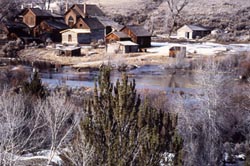
In 1862, a group of prospectors looking for gold camped by a creek surrounded by swarms of grasshoppers. Sifting through the sand of the stream they later named Grasshopper Creek, they found part of the biggest gold strike in Montana history.
In the few months between the gold discovery and the start of a hard, cold winter, over 500 people rushed to Bannack. They built a shantytown of tents and shacks to live in until spring arrived. Whenever gold was found in the Old West, towns were built quickly as people rushed to find their own fortune. When the gold disappeared, the people moved on, leaving behind the towns they'd built. These "ghost towns" of empty buildings are lonely and quiet reminders of what life was like for people of the frontier.
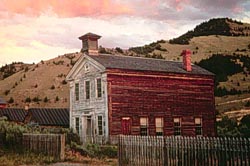
When the hard winter of 1862 was over, thousands more people came into the Bannack area. They came to pan for gold, using water to wash away the dirt, leaving the heavier gold dust behind. They crowded together near the best spots on the stream, living out of their tents and shacks until the gold ran out and they moved on. Rough roads to Salt Lake City and Virginia City were cut into the gulches going out of town.
Besides looking for gold, there wasn't much to do in early Bannack. Fights broke out often and there were no laws or police to stop them. Often, stagecoach robbers called road agents stole gold on its way to banks in eastern cities, by way of Virginia City. The 70-mile road to Virginia City was rough and hazardous enough, but road agents popping out from behind Road Agent's Rock made it even riskier for the stage drivers. Before and after robberies, the road agents hid out in a spot called Robber's Roost, a little over halfway between Bannack and Virginia City.
By May of 1863, the people of Bannack wanted law and order. They elected Henry Plummer as their sheriff to control the town and stop the road agents. Many of the same people would come to believe that Sheriff Plummer was keeping quite a secret. Plummer would be accused of leading the road gang that had been stealing the gold.
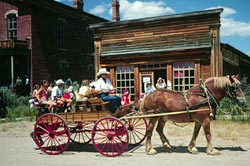
Accusers said Plummer picked members of the gang as his deputies and with the sheriff on its side, the gang robbed and killed over 100 men. There was no government authority or other law officer for the people of Bannack to call. The gang robbed more stagecoaches, committed crimes in broad daylight, and made life unsafe for everyone.
The gang was said to have spies working for local businesses, so they knew who had money and when the gold was leaving town. Skinner's Saloon, still standing in Bannack today, was their suspected headquarters. The owner, Cyrus Skinner, was later accused and hanged as a road agent. Legends say he buried a fortune in gold before he was caught.
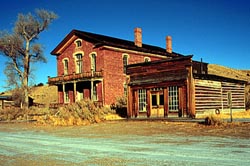
Finally, tired of the robberies and killings, a group of men called Vigilantes got together to hunt down around 30 of the suspected road agents and hang them, one by one, without trials.
One of the men that the Vigilantes caught was said to have told them that Sheriff Plummer was the gang's leader. The Vigilantes planned to meet in Bannack and capture him on January 10, 1864. They grabbed Plummer and two other men in the middle of the night. The next day, Plummer was hanged on the gallows he'd built while sheriff and was buried near it on Boot Hill above the town. After the Vigilantes had done their work there were no more robberies and murders in the area. Bannack's wild days were over.
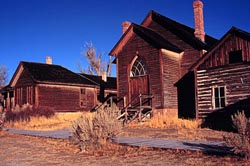
Montana became a territory of the United States in 1864. Only two years after gold had been discovered there, the little town of Bannack was picked as the capital of the Montana Territory, but only for a year. During that time, Montana's first territorial legislature met, passed the first laws, and approved the design of the first official seal.
The gold miners of Bannack had found millions of dollars in gold, but getting to the gold got harder. Most of the gold miners moved out of Bannack to work new gold fields, and the territorial government moved to a new capital in Virginia City.
By 1870, gold couldn't be found with a pan, pick, or shovel, and there were fewer than 300 people in Bannack. New techniques in gold mining brought mining companies to the area in the late 1880s, but Bannack's population never got above 418 again. Dredging creek bottoms (dredging boats were sort of big, floating shovels) and using water hoses brought out the last of Bannack's easier-to-get gold. The last residents of the town moved away in the 1940s.
Bannack is now a state park where visitors can see one of Montana's best-preserved ghost towns, frozen in time, all year. Once a year, though, on the third weekend of July, the town is brought back to life. People from around the state come to act the parts of Bannack's Vigilantes and villains. Stagecoach robberies, shootouts, gold panning, and other parts of Bannack's history entertain visitors. Virginia City and the rest of the Vigilante story are only a short drive away.
Bits and pieces of old mining equipment are still spread all over the valley. Parts of old dredges are visible in the creek bottoms. Visitors can camp close to town and mining companies still look for gold in the area, but Bannack's only residents today are park employees who work to preserve Bannack's buildings.
Learn More
Bannack State Park, Fish Wildlife and ParksBannack State Park, VisitMT.com
Updated: August 21, 2020

